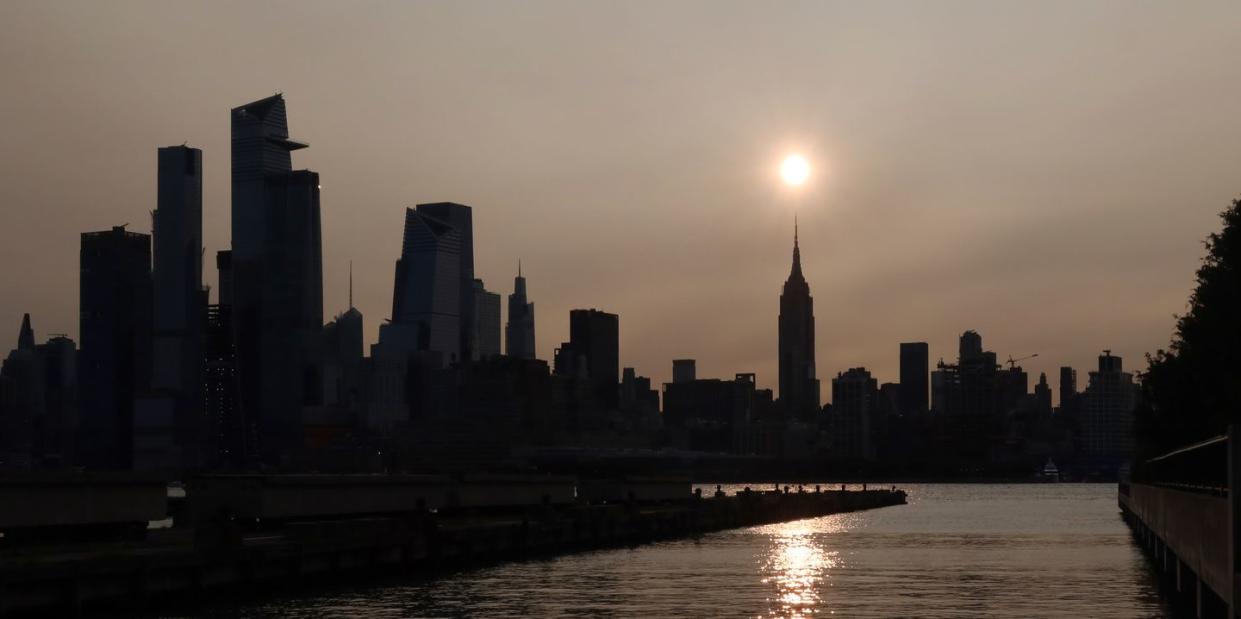Smoke From the West Coast Wildfires Is Causing Eerily Hazy Skies in the East Coast

Wildfires are raging across California, Oregon, and Washington State, forcing mandatory evacuations and destroying millions of acres of land.
Smoke from those fires has reached the East Coast, including New York City and Washington, D.C., more than 2,000 miles away from the blazes.
Wildfire smoke has even been reported as far away as the Netherlands.
As wildfires rage across huge swaths of California, Oregon, and Washington, social media has been flooded with images of smoke-obscured, orange skies over places like San Francisco and Portland. But now, that smoke is drifting across the rest of the country, causing hazy conditions as far away the Midwest and even the East Coast.
If you’ve noticed a milky, pink-tinged sky in the past few days, chances are you were underneath one of the huge, diffuse clouds of smoke that have been traveling across the United States on jet stream winds, according to the National Oceanic and Atmospheric Administration (NOAA). In New York City and Washington, D.C., clear skies were noticeably obscured by smoke particles on Tuesday.
CNN reports that two major plumes of smoke blew across the country earlier this week: one across the upper United States, from Michigan to New York; and one across the Southwest, terminating in the Mid-Atlantic. (View the NOAA’s current smoke forecasts here and here.)
Much of Canada has also been covered by plumes of wildfire smoke from the West Coast. And smoky, hazy skies are now being reported in Europe, as far away as the Netherlands. Before long, it could complete a journey around the globe.
The smoke from the western US wildfires has even reached the Netherlands (see Reeuwijk Lakes below), turning the sky is grey instead of blue. Confirmed to come from there by satellite and lidar observations, it is the layer above 6km height. Made worse by climate change. @KNMI pic.twitter.com/ZMRZkSIvuf
— Geert Jan van Oldenborgh (@gjvoldenborgh) September 11, 2020
For most of the country, the smoke is so high and diffuse that it’s mostly harmless. But along the West Coast interior and into the Rockies, air quality alerts remain in effect. As of press time, California, Oregon, Washington, and Idaho all have hazardous air quality, while moderate air quality has been reported in Montana, Wyoming, Arizona, and Colorado, according to the Interagency Wildland Fire Air Quality Response Program.
Notice that hazy, milky sky this morning? That is a result of smoke (well above our heads) from wildfires across the Western US. Notice that the smoke originates across the west and then gets pulled to the east due to the jet stream aloft. The haziness may increase later today. pic.twitter.com/wBOQHfpcmM
— NWS Wakefield (@NWSWakefieldVA) September 15, 2020
Although the particles tinting the skies in the eastern United States are not likely to cause any major problems, wildfire smoke can be dangerous even in small amounts. Per a 2017 study published in the journal Nature, particle pollution from wildfires is much more harmful than experts assumed.
“The biggest health threat from smoke is from fine particles,” the study explains. “They can cause a range of health problems, from burning eyes and a runny nose to aggravated chronic heart and lung diseases. Exposure to particle pollution is even linked to premature death.”
This year’s unprecedented fire season has already claimed millions of acres of land and at least 35 lives as of press time. California firefighters are battling the state’s largest wildfire ever, the August Complex fire, which is nearly 800,000 acres (over 1,200 square miles) large and only 30% contained, according to the National Wildfire Coordinating Group.
When enough smoke is produced from a wildfire, pyrocumulonimbus clouds form, sending smoke high into the atmosphere and into the path of jet streams, which allow it to travel huge distances. The three largest pyrocumulonimbus events ever recorded, according to The San Francisco Chronicle, have all happened in the past three years, likely as a result of climate change, experts say.
You Might Also Like

 Yahoo News
Yahoo News 
